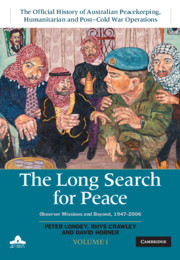Book contents
- The Long Search for Peace
- The Official History of Australian Peacekeeping, Humanitarian and Post–Cold War Operations
- The Long Search for Peace
- Copyright page
- Contents
- Maps
- Preface
- Glossary
- Part 1 Actor and observer
- 1 The origins of peacekeeping
- 2 St George and the maiden
- 3 Inventing peacekeeping
- 4 Failure
- 5 Success
- 6 Observing at a critical moment
- 7 An intractable dispute
- 8 ‘Tough men wanted’
- 9 Australia and the problem of Palestine
- 10 The Six Day War and after
- 11 ‘If you’re not confused, you don’t understand the situation’
- 12 Over jungle and swamp
- 13 A reluctant start
- 14 The first decade
- 15 Australia and the invention of peacekeeping
- Part 2 New ambitions
- Part 3 Carrying on
- Conclusion
- Book part
- Bibliography
- Index
- Plate Section (PDF Only)
12 - Over jungle and swamp
Australian Army helicopters in West New Guinea, 1962–63
from Part 1 - Actor and observer
Published online by Cambridge University Press: 27 September 2019
- The Long Search for Peace
- The Official History of Australian Peacekeeping, Humanitarian and Post–Cold War Operations
- The Long Search for Peace
- Copyright page
- Contents
- Maps
- Preface
- Glossary
- Part 1 Actor and observer
- 1 The origins of peacekeeping
- 2 St George and the maiden
- 3 Inventing peacekeeping
- 4 Failure
- 5 Success
- 6 Observing at a critical moment
- 7 An intractable dispute
- 8 ‘Tough men wanted’
- 9 Australia and the problem of Palestine
- 10 The Six Day War and after
- 11 ‘If you’re not confused, you don’t understand the situation’
- 12 Over jungle and swamp
- 13 A reluctant start
- 14 The first decade
- 15 Australia and the invention of peacekeeping
- Part 2 New ambitions
- Part 3 Carrying on
- Conclusion
- Book part
- Bibliography
- Index
- Plate Section (PDF Only)
Summary
Between 18 November and 25 December 1962, eleven members of the Australian Army’s 16 Light Aircraft Squadron were deployed to West New Guinea (now the Indonesia province of Papua) to assist with efforts to control an outbreak of cholera. This was essentially a humanitarian mission, but it became part of a wider UN peacekeeping mission, namely the United Nations Temporary Executive Authority (Untea) in West New Guinea, which operated from October 1962 to April 1963. The mission, which enjoyed the support of both Indonesia and the Netherlands, was held up as one of the success stories of the United Nations’ first 20 years of peacekeeping operations, satisfying its mandate on schedule and under budget. In a technical sense this was true, but Untea faced constant pressure from Indonesia and, in the end, the United Nations failed to uphold the right of the West New Guinea people to self-determination.
- Type
- Chapter
- Information
- The Long Search for PeaceObserver Missions and Beyond, 1947–2006, pp. 295 - 317Publisher: Cambridge University PressPrint publication year: 2019

